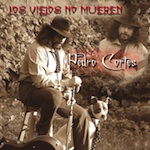Pedro Cortes
Click a release for info and music:
 Pedro Cortes Los Viejos No Mueren |
|
Pedro Cortes is from a family of Spanish Gypsy guitarists and grew up both in Andalusia and New York City, where his father came to for performances at the Spanish Pavillion at the World's Fair. He began his studies with his father and the esteemed Flamenco guitarist Sabicas, one of the four most influential figures in the history of that instrument. Touring as a professional Flamenco guitarist since the age of 17, he is now gaining recognition as a composer with influences that expand the Flamenco tradition, including from the classical, Latin, rock, and jazz worlds.
As a composer, his En la oscuridad de las minas played at
the Teatro Albeniz in Madrid, and other works were
premiered by the Carlota Santana Spanish Dance Company at the Joyce
Theater in New York. He haswritten two books on Flamenco, El Dron
del Faraon and Cruzando el Charco, published by the
American Institute of Guitar.
Mr. Cortes, was commissioned by the Cohen Brothers to compose music for the film Paris Je T'Aime and has written soundtracks for HBO. He was Musical Director with the Guthrie Theater In Garcia Lorcas BODAS DE SANGRE.
As a flamenco guitarist, he toured with Jose Greco and Maria Benitez, La Conja and performed with Farrucita, La Tati, Merche Esmeralda, Manolete and the great late Lola Flores. He has been guest artist with the St. Louis Opera and the New York Grand Opera, and has been commissioned by the Guthrie Theater.
![]() "Cortes
now performs weekly at a makeshift club called Alegrias, on the second
floor of the Spanish Benevolent Society, on West Fourteenth Street in
Manhattan. On most Saturday nights, the Society’s plain space is
transformed into an Andalusian tablao: white tablecloths,
chorizo tapas, and aficionadas dressed in billowy black dresses with
red carnations in their hair. Recently, Cortes took the stage with a
goatee and long, curly black hair suggesting a seventies-era fan of
Led Zeppelin (which he was). He began the first set with a stark,
mournful soleá, one of the oldest, most haunting flamenco
forms, accompanied by a cajón (a boxlike percussion
instrument played with one’s hands), castanets, and a singer. After an
elegiac instrumental introduction, a male and a female dancer emerged
onto the tiny stage. Facing each other, they drew close and pulled
apart in a tight circle with exacting, provocative gestures. Cortes
watched the pair intently and then, turning his gaze toward the
singer, began the song’s finale, a series of beautiful falsetas—brief,
melodic phrases—that underpinned the dancers’ climactic movements. “My
father taught me how to look at the singer and the way he’s
breathing,” he said later. “If he usually takes in air fast, that
means he’s going to probably come in fast on the next phrase.”
"Cortes
now performs weekly at a makeshift club called Alegrias, on the second
floor of the Spanish Benevolent Society, on West Fourteenth Street in
Manhattan. On most Saturday nights, the Society’s plain space is
transformed into an Andalusian tablao: white tablecloths,
chorizo tapas, and aficionadas dressed in billowy black dresses with
red carnations in their hair. Recently, Cortes took the stage with a
goatee and long, curly black hair suggesting a seventies-era fan of
Led Zeppelin (which he was). He began the first set with a stark,
mournful soleá, one of the oldest, most haunting flamenco
forms, accompanied by a cajón (a boxlike percussion
instrument played with one’s hands), castanets, and a singer. After an
elegiac instrumental introduction, a male and a female dancer emerged
onto the tiny stage. Facing each other, they drew close and pulled
apart in a tight circle with exacting, provocative gestures. Cortes
watched the pair intently and then, turning his gaze toward the
singer, began the song’s finale, a series of beautiful falsetas—brief,
melodic phrases—that underpinned the dancers’ climactic movements. “My
father taught me how to look at the singer and the way he’s
breathing,” he said later. “If he usually takes in air fast, that
means he’s going to probably come in fast on the next phrase.”
-excerpt from a New
Yorker profile of Pedro by Dan Kaufman